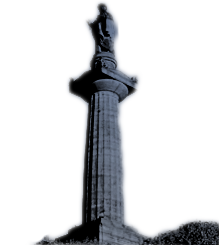John Dick was born in Aberdeen on 18th October 1764, son of the Rev Alexander Dick, a native of Kinross and minister of the Secession Church in Aberdeen, and Helen Tolmie.
 John was educated at Aberdeen Grammar school and then to University in Aberdeen, entering Kings College in October 1777 at the age of 13 with a bursary. The advantage of the bursary swayed him towards Kings College rather than Marischal’s College. He studied humanity, Greek and philosophy under Professors Ogilvie, Leslie and Dunbar respectively and on 30th March 1781 was awarded the degree of M.A.
John was educated at Aberdeen Grammar school and then to University in Aberdeen, entering Kings College in October 1777 at the age of 13 with a bursary. The advantage of the bursary swayed him towards Kings College rather than Marischal’s College. He studied humanity, Greek and philosophy under Professors Ogilvie, Leslie and Dunbar respectively and on 30th March 1781 was awarded the degree of M.A.
Translation of the greek inscription :
O tell me not the good man dies
Embalmed in sacred sleep he lies
His monument was designed by architect Robert Black and is one of many in the Necropolis based on the Choragic Monument of Lysicrates. It was erected 5 years after his death and is missing and an urn and finial.
On leaving university, some friends attempted to persuade him to join the ministry to the Church of Scotland, others to the Episcopalian Church and his father tried to dissuade him from joining the ministry at all. John however was determined to join the ministry of the Secession church, like his father. He was admitted by the Associate presbytery of Perth and Dunfermline and spent 5 years studying under John Brown in Haddington. During that time he spent most of his holidays with a paternal uncle who ëassisted him to rid himself of the provincial peculiarities by which he was disfigured’.
On reaching the age of 21 in 1785 he became a licensed preacher within the Perth and Dunfermline Presbytery and rapidly gained a reputation for his conduct of services and prowess as a preacher. This soon led to calls from three congregations, Scone, Musselburgh and Slateford. He accepted the invitation from Slateford, a village near Edinburgh and was ordained on 26th October 1786 at the age of 22. For the first year there was no manse and he lodged with Dr Peddie of Edinburgh.
On moving to the new manse at Slateford he also created a fine garden and after a few years married Jane Coventry, daughter of Rev George Coventry of Stitchell in Roxburghshire.
During his fifteen years at Slateford, John had been called twice to his late father’s church in Aberdeen but on both occasions declined. In 1801 he was ëcalled’ to Greyfriars Church in Glasgow. The Synod agreed and though John Dick had not expressed an opinion either way he agreed to be assistant to Rev Alexander Pirie. It was a painful separation for both John and his Slateford congregation. Greyfriars, in Shuttle St, Glasgow, was one of the oldest and wealthiest church in the Secession church and Dr Dick was inducted as colleague and successor to Dr Pirrie on 21st May 1801 and succeeded Dr Pirrie on his death in 1810.
In 1815 John Dick received the degree of Doctor of Divinity from the College of Princetown, New Jersey, USA and in 1820 he was appointed Theological Professor to the Associate Synod to replace Dr Lawson of Selkirk who had died in 1819. This position he held single handed till 1825 when a second Professor, Rev Dr John Mitchell was appointed to cover biblical literature.
In 1832 Dr Dick was appointed President of the Auxiliary Bible Society of Glasgow in place of the Earl of Glasgow who had resigned.He also took on the presidency of the Glasgow Voluntary Church Association.
In 1833 Dr Dick became ill with an inner ear infection and died two days later on 25th January 1833 in his 69th year. He was buried at the High Kirk / Glasgow Cathedral and there is a fine memorial to him and his family in Glasgow Necropolis. This was erected by his congregation.
John and Jane Dick had four children including Helen Dick (1792 – 1883) and became the wife of Humphry Crum Ewing (1802 – 1887) who also has a memorial in Glasgow Necropolis.
John Dick’s publications include:-
1788
The Conduct and Doom of False Teachers
1796
Confessions of the Faith shown to be necessary and the Duty of Churches with respect to them Explained
1796-1800
He was a regular contributor to the Christian Magazine under the pseudonym of Chorepiscopus
1800
An Essay on the Inspiration of the Scriptures
(this was so popular in church circles that it was published in 3 editions)
1816
A volume of sermons
1834
4 Volumes of his sermons were published with a memoir prefix.
2 Volumes of lectures on The Acts of the Apostles










